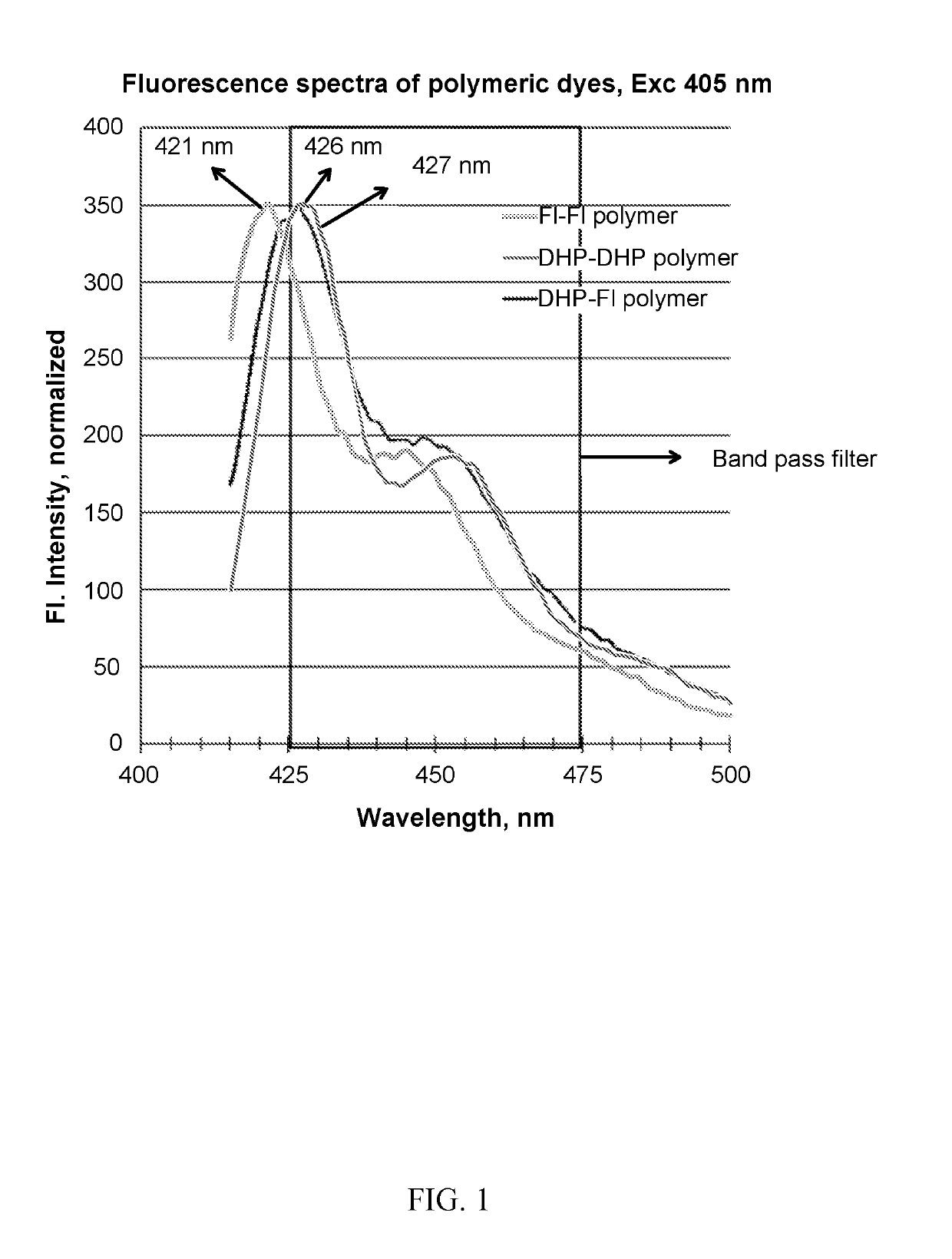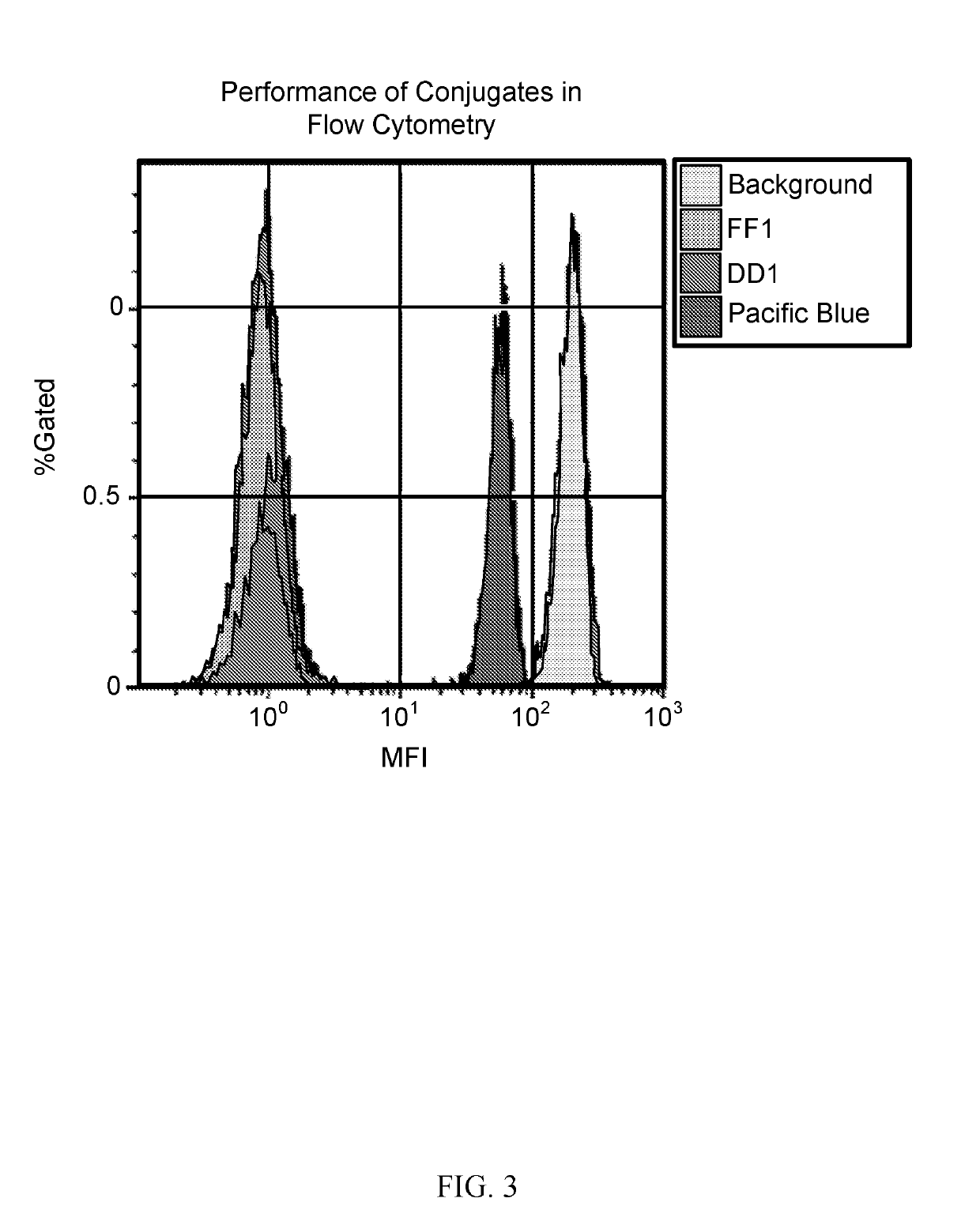Photoactive macromolecules and uses thereof
a macromolecule and photoactive technology, applied in the field of complexes and methods for detecting analytes, can solve the problems that many polymeric dyes are not useful under aqueous conditions
- Summary
- Abstract
- Description
- Claims
- Application Information
AI Technical Summary
Benefits of technology
Problems solved by technology
Method used
Image
Examples
example 1
on of DHP Polymer Complex
[0149]
[0150]Method 1: In a round bottom flask both the dibromo DHP and diboronic DHP monomers (1:1) were taken in (DMF-water) mixture and purged with nitrogen for 10 minutes. Under nitrogen about 20 equivalent of CsF and 10% of Pd(OAc)2 were mixed and heated at 80deg Celsius. Polymerization was monitored using UV-Vis spectroscopy and SEC chromatography. Later to the reaction mixture, a capping agent (selected from G1) containing appropriate functional group was added and 3 hours later the second capping agent (selected from G2) added. After the reaction the crude reaction mixture was evaporated off and passed through a gel filtration column to remove small organic molecules and low MW oligomers. Later the crude polymer passed through a Tangential flow filtration system equipped with a 100K MWCO membrane. It is washed using 20% ethanol until the absorption of the filtrate diminishes.
[0151]Method 2: Alternatively, the polymerization can be done by self-polymer...
example 2
on of Fluorene-DHP Copolymer Complex
[0154]
[0155]Method 1: In a round bottom flask both the dibromo DHP and diboronic fluorene monomers (1:1) were taken in (DMF-water) mixture and purged with nitrogen for 10 minutes. Under nitrogen about 20 equivalent of CsF and 10% of Pd(OAc)2 were mixed and heated at 80deg Celsius. Polymerization was monitored using UV-Vis spectroscopy and SEC chromatography. Later to the reaction mixture, a capping agent (selected from G1) containing appropriate functional group was added and 3 hours later the second capping agent (selected from G2) added. After the reaction the crude reaction mixture was evaporated off and passed through a gel filtration column to remove small organic molecules and low MW oligomers. Later the crude polymer passed through a Tangential flow filtration system equipped with a 100K MWCO membrane. It is washed using 20% ethanol until the absorption of the filtrate diminishes.
[0156]Method 2: In a round bottom flask both the dibromo fluo...
example 5
[0161]The flow cytometric analysis of lysed whole blood stained with the new polymers-labeled anti-human CD4 and Pacific Blue-labeled CD4 was undertaken. The positive signal intensity of polymer dyes were nearly 5 times higher than Pacific Blue (FIG. 3).
PUM
| Property | Measurement | Unit |
|---|---|---|
| Fraction | aaaaa | aaaaa |
| Fraction | aaaaa | aaaaa |
| Fraction | aaaaa | aaaaa |
Abstract
Description
Claims
Application Information
 Login to View More
Login to View More - R&D
- Intellectual Property
- Life Sciences
- Materials
- Tech Scout
- Unparalleled Data Quality
- Higher Quality Content
- 60% Fewer Hallucinations
Browse by: Latest US Patents, China's latest patents, Technical Efficacy Thesaurus, Application Domain, Technology Topic, Popular Technical Reports.
© 2025 PatSnap. All rights reserved.Legal|Privacy policy|Modern Slavery Act Transparency Statement|Sitemap|About US| Contact US: help@patsnap.com



